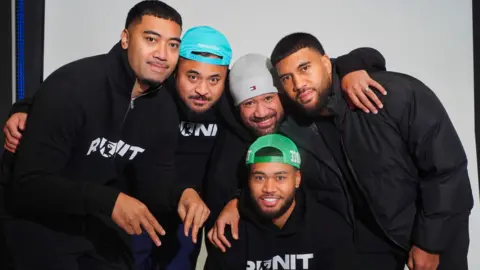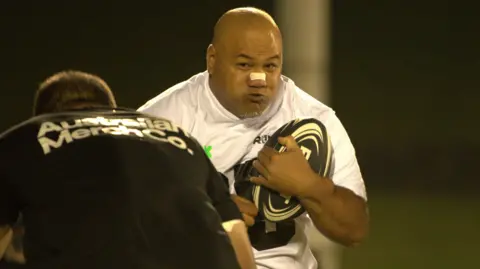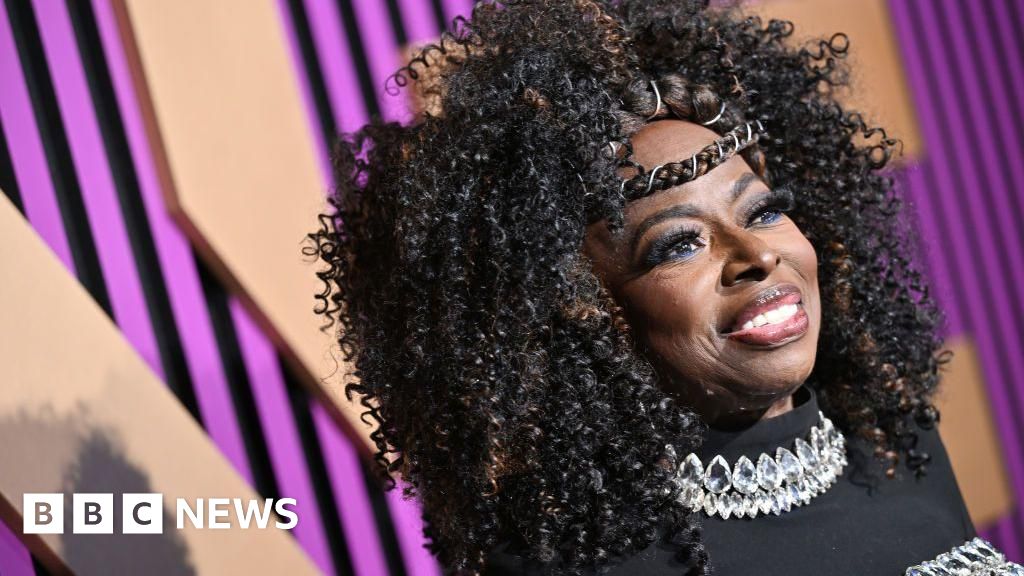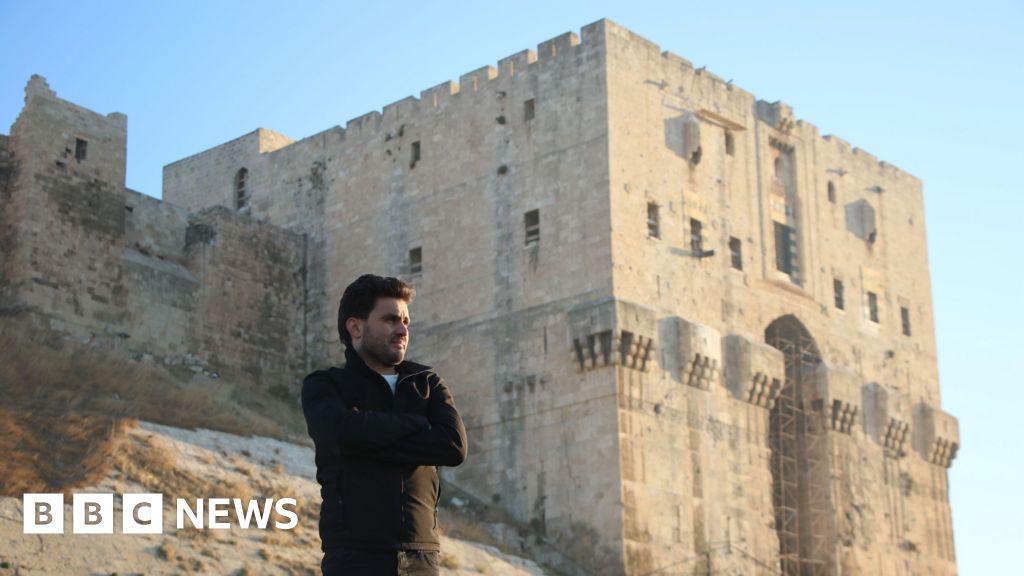BBC News, Sydney
“Defender ready?” calls the host.
A thumbs up and moments later, two burly men – with no protective gear – run full speed at each other before they clash, the unmistakable sound of flesh and bone crunching.
The crowd erupts into a collective roar, some cheering, others wincing.
This is the moment they’ve been waiting for – and it’s exactly this adrenaline-fuelled energy that organisers of the Run It Championship League are banking on to help bring what they call the “world’s fiercest, new collision sport” to global audiences.
It is a supercharged version of a one-on-one tackle game which originated in the backyards and school playgrounds of Australia and New Zealand – namely in Pacific Islander communities.
One person carrying a ball must “run it straight” at the defender, who is also sprinting towards them: they are not allowed to duck, hurdle or sidestep the tackler.
Videos of the game have recently gone viral, and the founders of the Run It league have capitalised on the surge of interest – they say they’ve gained millions of views online, won over thousands of fans, attracted big name sponsors, and even inspired rival competitions.
They’ve held jousts in Melbourne and Auckland, and on Saturday another will take place in a Dubai arena, the winner taking away prize money of A$200,000 (£98,000). Next on their agenda, is an expansion to the UK and US.
But the groundswell of support for the league is increasingly being rivalled by critical voices. Medical experts and sporting figures are worried about the physical and mental health impacts of the game – which has also become a wider social media craze, that is already accused of claiming one life.
“It’s like shaking a baby,” says Peter Satterthwaite, whose teenage nephew died after copying the game at a party.
From the schoolyard to the world stage
 Luis Enrique Ascui/THE AGE/SMH
Luis Enrique Ascui/THE AGE/SMHThe objective of the game is simple: be the person who “dominates” the contact, as deemed by a panel of three judges.
Two of the league’s seven co-founders, Brandon Taua’a and Stephen Hancock, tell the BBC they have fond memories of playing the game as teenagers in Melbourne.
“I used to ‘run it straight’ at Brandon all the time,” Hancock says, joking that the pair would usually try to avoid hitting each other straight on.
There’ll be none of that this weekend, when the eight finalists compete for that giant cash prize in United Arab Emirates.
Hancock insists Run It is a “game of skill” – “[It’s] all about the footwork” – but there’s no denying the violent nature of it.
A quick scroll of the league’s social media accounts shows dozens of quick-burst videos, all honing in on the explosive action of two men colliding.
In other videos circulating from the events, several competitors are knocked out and require immediate medical attention.
Taua’a acknowledges the sport comes with risks, but says the league has safety protocols to minimise them.
Competitors are screened, undergoing medical assessments – such as blood tests and a physical exam – and they must also send a recent video of themselves playing a sport that features tackling. Medical staff are also on the sidelines of the events.
“There’s an element of danger with surfing, with boxing, and many other sports as well,” Taua’a argues.
For Champ Betham – who won NZ$20,000 earlier this month at the competition in Auckland and is gunning for the title in Dubai on Saturday – the element of danger is a secondary consideration.
“This is a massive blessing to a whole heap of us to pretty much try and win 20K or whatever for a couple hours’ work,” he told Radio New Zealand at the time.
“We got to pay off some debts and stock up the fridges and the cupboards, food for our little ones, especially with the economy and stuff like that here in New Zealand. Nothing’s cheap these days.”
 Getty Images
Getty ImagesThe money involved, for a league which has only been around for six months, is impressive. Along with the prize fund, competitors’ travel and accommodation expenses are being paid. A 1,600-seat arena has been booked. The league has a slick social media account, a PR representative, and a bunch of promoters – including antipodean sports stars.
Its initial financial backers have been described only as “a group of local investors who believe in the product”, but bigger names are emerging: days before the Dubai event, the league announced it had secured a major sponsor in online gambling platform Stake.com, which is banned in key markets like Australia and the UK.
There are also ongoing talks with potential US investors, including a contact linked to American podcaster and UFC heavyweight Joe Rogan, which Taua’a says “will definitely help” the league build a presence in the US.
They will need big backers to match their ambitions for the contest, which they argue is more than just a fleeting social media trend.
“This could actually eventuate into a sport that could sit [in a class] with MMA and boxing,” Hancock says.
‘An innocuous clash’
But as Taua’a and Hancock focus on the competition’s future ambitions, more and more voices are questioning its safety.
“They might as well set up smoking as a legitimate sport,” says neuroscientist Alan Pearce.
Speaking to the BBC from the New Zealand city of Palmerston North, Peter Satterthwaite is unequivocal.
“It’s not a sport,” he says. It’s “a dangerous activity” designed purely “to hurt the guy in front of you”.
His 19-year-old nephew Ryan was celebrating a 21st birthday with friends at a local park when they decided to try the game they’d seen all over their social media feeds.
Ryan did two tackles. Neither he or his friend fell down or clashed heads. But as he walked away, he told his mates he didn’t feel well, his uncle recounts.
“[Ryan] was coherent for a bit, then he lay down and his eyes just rolled back in his head.”
 Pete Satterthwaite
Pete SatterthwaiteFriends rushed him to hospital where doctors had to “cut a sizable chunk out of his skull” to alleviate pressure caused by brain swelling, Satterthwaite says.
“I saw him on the ventilator, his chest going up and down as he was breathing, and it was like ‘Get up! Open your eyes’.”
On Monday evening, just a day after he was playing with his mates, Ryan’s life support was turned off in a hospital room filled with loved ones.
“It was just an innocuous clash,” Ryan’s uncle says, “and it just shows you how fragile life is and how fragile your brain is.”
Run It says it understands the dangers of contact sports and takes safety seriously. Weeks after Ryan’s death, the league posted a video saying the game is “not for the backyard, not for the street”.
“Do not try this at home,” they said.
But Satterthwaite doubts that warning will have much impact.
“I don’t think there’s a sport in the world that people don’t do at the beach, or in their backyard, or at the park.”
It’s not just the physical impacts that worry Shenei Panaia.
 Shenei Panaia
Shenei PanaiaAs a Samoan growing up in Australia, she would often see schoolkids playing the game as a bit of fun. But the mental health worker fears it reinforces “a version of masculinity where silence is strength, and violence is proof of pride”.
“It sends a dangerous message to young men that their worth is based on how much pain they can take. That if you’re not tough, you don’t belong.”
And the league’s attempt to turn this into a lucrative spectator sport contradicts the values of many in the Pacific Islander community, Penaia says.
“We are taught to look out for one another… and to make decisions that serve more than just ourselves.”
‘Blood in the air’
Their concerns are echoed by a pack of concussion experts and sporting figures.
For more than a decade, the world of high-impact sports has been introducing safety measures as the research into brain injuries develops.
Official bodies including Rugby Australia, New Zealand Rugby have warned people not to take part, with the New Zealand Prime Minister also weighing in, saying it’s a “dumb thing to do”.
 RUNIT
RUNITNeuroscientist Pearce argues Run It magnifies “the most violent aspects of our established sport”, while the safety protocols do little to minimise any risk. Blood tests and physical exams cannot predict a brain injury, and catastrophic damage can occur even without a direct hit to the head, he says.
“I can’t see how running at 25km an hour straight at each other without stopping is safe,” he tells the BBC. “It’s as simple as that.”
There’s the risk of immediate concussion, Dr Pearce says, delayed onset brain injuries like Ryan Satterthwaite’s, and chronic traumatic encephalopathy (CTE) – a degenerative disease caused by repetitive head trauma. They can lead to cognitive impairments, movement disorders, dementia, depression.
“[They’re] basically using the collision as the entertainment value, which is, in effect, commercialising concussion,” he concludes.
But a spokesperson for the league – who argues it is “not about masculinity” but “strength and skill” – say organisers have no intention of slowing down, and aren’t too worried about their critics.
Taua’a says what happens at their competitions is “not too much different” to what you see on televised rugby matches, and – with their protocols – it is far safer than many of the games played in backyards the world over.
“It’s quite new for viewers and it might take some time for them to get used to seeing what we’ve put together.”




